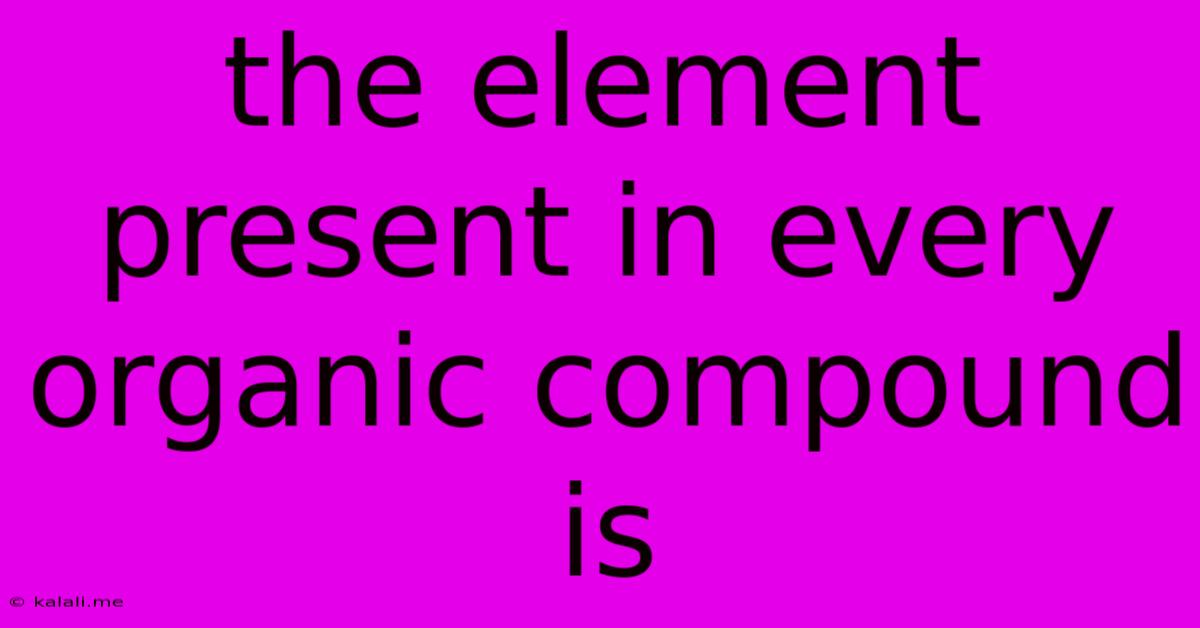The Element Present In Every Organic Compound Is
Kalali
Jun 12, 2025 · 3 min read

Table of Contents
The Element Present in Every Organic Compound: Carbon
Organic chemistry is the study of carbon compounds, and the very definition hinges on the presence of a single element: carbon. This seemingly simple statement underlies a vast and complex field of study encompassing the molecules of life and countless synthetic materials. But why carbon? What makes it so special that it forms the backbone of all organic compounds?
This article will delve into the unique properties of carbon that allow it to form the incredible diversity of molecules we see in the organic world, from simple hydrocarbons to complex biomolecules like DNA and proteins. We'll explore its bonding capabilities and how these contribute to the vast array of organic structures. Understanding this fundamental principle is crucial for anyone venturing into the fascinating world of organic chemistry.
Carbon's Unique Bonding Capabilities: The Key to Organic Diversity
The key to carbon's dominance in organic chemistry lies in its electronic structure. Carbon possesses four valence electrons, meaning it can form four covalent bonds with other atoms. This tetravalency allows carbon to form long chains, branched structures, and rings—a versatility unmatched by other elements. This ability to catenate, or bond to itself, is crucial for building complex molecules.
Consider the simplest organic molecule, methane (CH₄). Carbon forms four single bonds with four hydrogen atoms, creating a stable tetrahedral structure. However, this is just the beginning. Carbon can also form double bonds (as in ethene, C₂H₄) and triple bonds (as in ethyne, C₂H₂), further expanding the possibilities of molecular architecture. These multiple bonds introduce variations in bond length and reactivity, adding another layer of complexity to organic chemistry.
The Variety of Organic Compounds: From Simple to Complex
The ability of carbon to form diverse bonds, along with its ability to bond with a wide range of other elements like hydrogen, oxygen, nitrogen, sulfur, and halogens, contributes to the astonishing variety of organic compounds. These compounds exhibit an incredible range of properties and functions:
- Hydrocarbons: These are the simplest organic compounds, consisting solely of carbon and hydrogen atoms. They form the basis for many other organic molecules and are found in fuels like petrol and natural gas. Examples include alkanes, alkenes, and alkynes.
- Alcohols: Containing the hydroxyl (-OH) functional group, alcohols exhibit diverse properties depending on the size and structure of the carbon chain. Ethanol, a common alcohol found in alcoholic beverages, is a prime example.
- Carboxylic Acids: Characterized by the carboxyl (-COOH) group, carboxylic acids are important in many biological processes and are frequently found in fats and oils. Acetic acid, the main component of vinegar, is a well-known example.
- Amines: Containing a nitrogen atom bonded to one or more carbon atoms, amines are crucial building blocks in many biological molecules like amino acids, the monomers of proteins.
- Carbohydrates, Lipids, Proteins, and Nucleic Acids: These four classes of biomolecules are all based on carbon skeletons and represent the incredible complexity achievable through carbon's bonding versatility. They are essential for the structure and function of all living organisms.
Beyond the Basics: The Ongoing Exploration of Organic Chemistry
The study of organic compounds continues to be a vibrant and expanding field. Researchers are constantly discovering new compounds, synthesizing novel materials, and unraveling the complexities of biological molecules. From developing new pharmaceuticals to creating sustainable materials, the implications of organic chemistry are vast and far-reaching.
In conclusion, carbon is the quintessential element present in every organic compound. Its unique ability to form four covalent bonds, catenate, and bond with a wide range of other elements allows for the creation of an astounding diversity of molecules, shaping the world around us from the molecules of life to the materials we use every day.
Latest Posts
Latest Posts
-
Which Statement About Gases Is True
Jun 13, 2025
-
Female Reproductive System Questions And Answers Pdf
Jun 13, 2025
-
What Do You Mean By Bloody Sunday Class 9
Jun 13, 2025
-
Which Element Has The Highest Ionization Potential
Jun 13, 2025
-
The Biggest Gulf In The World
Jun 13, 2025
Related Post
Thank you for visiting our website which covers about The Element Present In Every Organic Compound Is . We hope the information provided has been useful to you. Feel free to contact us if you have any questions or need further assistance. See you next time and don't miss to bookmark.